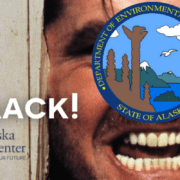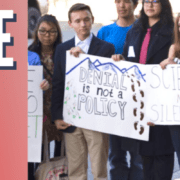It’s baaaaack!
Last week, we wrote about the approximately $5 Million that the Governor is requesting for the Department of Environmental Conservation (DEC) to hire 32 full-time staff to take over and administer wetland dredge and fill permitting currently done by the federal government EPA. Ironically, at the same time that DEC is asking for more responsibility over permitting (to benefit large scale mining development); they are also trying to dodge their responsibility to administer protections for high ecological value waters under the federal Outstanding National Resource Waters. Instead, they have introduced HB 398, which would require that the Legislature take responsibility.
HB 398 is the 2022 version of a bill that has been around for many many years, and different legislative sessions – yet has never enjoyed enough support to pass. In essence, it would require that high-value water protection be determined by the state legislature instead of through DEC regulation. HB 398 seeks to make it impossible for Alaskans to protect waters of high ecological value as Tier III waters under the Clean Water Act. Right now, federal law requires states to craft a process for citizens to nominate pristine high-value (fish spawning, culturally critical, etc.) top Tier or Tier III waters for protection from pollution. DEC is legally authorized to protect waters under a Tier III status, but they don’t want to do it.
Instead of DEC simply taking legal responsibility to protect high-value waters nominated by Alaskans, they propose HB 398, which creates more bureaucracy, expense, and red tape that strips Alaskans of our right to protect our waters. This bill is bad.
It would remove Alaskan’s right to have a voice in protecting water in Alaska by putting the power in the hands of politicians instead of the experts with Indigenous, local, and scientific knowledge.
It would allow committee chairs in the House and Senate to prevent Tier III nominations from moving through the Legislature, creating a de facto ban on water protections.
It would take power away from Alaskans and give an upper hand to outside mining companies and big businesses with no interest in protecting our fisheries and the clean water.
It would create additional bureaucracy, expense, and political paralysis that leaves our most essential and vulnerable waterways unprotected.
It would put our $2 billion salmon industry at risk.
It would silence constituents from being a part of the decision-making process around the use of waters integral to our cultures, livelihoods, and survival.
Legislative attorneys have time and again concluded that DEC can already establish and administer a process for Alaskans to seek the protection of high-value water through agency regulation. DEC has time and time again sought to shirk its responsibility, hiding behind bogus legal interpretations and philosophical objections.
Why should the Legislature approve increasing the budget to give DEC the complex responsibility of permitting mining projects in wetlands that support our salmon when, simultaneously, DEC is telling everyone with HB 398 that it does not want to be the agency to protect salmon?
Keep an eye on this bad bill.




